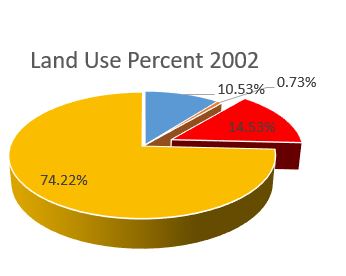Concrete Expansion: Urban Growth Estimation Through Geo informatics, A Case Study of Karachi
Keywords:
RS, GIS, Urban Growth, Urbanization, Change DetectionAbstract
Karachi, once the capital of Pakistan and currently the capital of Sindh province, is the country’s largest city and the 12th most populous city globally. It plays a crucial role in the national economy, contributing 60-70% of the country's total revenue. However, the city faces significant challenges due to rapid urban sprawl—a prevalent issue in developing countries. The uncontrolled expansion of Karachi’s urban area, often described as the “concrete jungle,” presents considerable risks due to inadequate management and lack of long-term planning. This uncontrolled growth has led to increased population density, resource deficits, management challenges, and ecological pressures. Remote sensing and GIS technologies are now being employed for change detection and urban expansion analysis. Satellite data, including both current and historical images in various spatial resolutions, facilitate this analysis. In this study, change detection techniques are used to assess Karachi's urban growth through historical maps, employing Landsat 7 ETM+ images from 2002 and Landsat 8 OLI images from 2022. This analysis, based on satellite images and measurements, reveals that Karachi's population has grown at an annual rate of approximately 4%, driven by high natural increase and substantial migration from other regions. The population increased from 9.34 million in 1998 to 15 million in the 2017 census. Over the past 20 to 25 years, Karachi has expanded at a rate of about 15% annually, adding approximately 2 square kilometers per year to accommodate its growing population, resulting in a notably high population density.
References
“Karachi’s Stone Age proves history didn’t start with the Muslims.” Accessed: Jul. 04, 2024. [Online]. Available: https://tribune.com.pk/story/626458/the-flintstones-karachis-stone-age-proves-history-didnt-start-with-the-muslims
“Hasan, A. and Mohib, M. (2003) Urban Slums Reports The Case of Karachi, Pakistan. - References - Scientific Research Publishing.” Accessed: Jul. 04, 2024. [Online]. Available: https://www.scirp.org/reference/referencespapers?referenceid=1110278
“Population and the urban future - PubMed.” Accessed: Jul. 04, 2024. [Online]. Available: https://pubmed.ncbi.nlm.nih.gov/12311446/
“Data on urbanization and migration.” Accessed: Jul. 04, 2024. [Online]. Available: https://www.migrationdataportal.org/themes/urbanization-and-migration
“70 years of urban growth in 1 infographic.” Accessed: Jul. 04, 2024. [Online]. Available: https://www.weforum.org/agenda/2019/09/mapped-the-dramatic-global-rise-of-urbanization-1950-2020/
“Urbanization, United nation Population Fund.” Accessed: Jul. 04, 2024. [Online]. Available: https://www.unfpa.org/urbanization
“Pakistan | History, Population, Religion, & Prime Minister | Britannica.” Accessed: Jul. 04, 2024. [Online]. Available: https://www.britannica.com/place/Pakistan
S. Afsar, S. J. H. Kazmi, and S. Bano, “Quest of Urban Growth Monitoring from Myth to Reality,” J. Basic Appl. Sci., vol. 9, pp. 222–230, Jan. 2013, doi: 10.6000/1927-5129.2013.09.29.
“Karachi | History, Population, Climate, & Facts | Britannica.” Accessed: Jul. 04, 2024. [Online]. Available: https://www.britannica.com/place/Karachi
“Economy - Government of Sindh.” Accessed: Jul. 04, 2024. [Online]. Available: https://www.sindh.gov.pk/economy
“About Karachi | Port Qasim Authority - PQA.” Accessed: Jul. 04, 2024. [Online]. Available: https://www.pqa.gov.pk/en/about-us/about-us/port-qasim-at-glance/about-karachi
J. D. Marshall, “Urban Land Area and Population Growth: A New Scaling Relationship for Metropolitan Expansion,” http://dx.doi.org/10.1080/00420980701471943, vol. 44, no. 10, pp. 1889–1904, Sep. 2007, doi: 10.1080/00420980701471943.
“Urbanization - Our World in Data”, Accessed: Jun. 16, 2024. [Online]. Available: https://ourworldindata.org/urbanization
“An urbanizing world.” Accessed: Jul. 04, 2024. [Online]. Available: https://www.researchgate.net/publication/285676310_An_urbanizing_world
A. Hasan, “Emerging urbanisation trends: The case of Karachi Emerging Urbanization Trends: The case of Karachi,” no. May, 2016, [Online]. Available: https://www.theigc.org/wp-content/uploads/2016/12/Hasan-2016-Academic-Paper.pdf

Downloads
Published
How to Cite
Issue
Section
License
Copyright (c) 2024 50SEA

This work is licensed under a Creative Commons Attribution 4.0 International License.




















